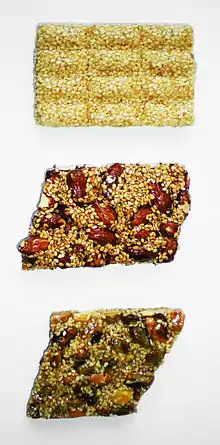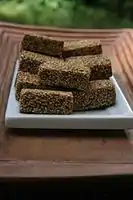Sesame seed candy
Sesame seed candy is a confection of sesame seeds and sugar or honey pressed into a bar or ball. It is popular from the Middle East through South Asia to East Asia. The texture may vary from chewy to crisp. It may also be called sesame (seed) candy/bar/crunch; sesame seed cake may refer to the confection or to a leavened cake or cookie incorporating sesame.
 Three varieties of sesame seed candy. | |
| Type | Confectionery |
|---|---|
| Place of origin | Unknown; possibly Middle East |
| Main ingredients | Sesame seeds, sugar or honey |
- The term "sesame candy" may also refer to sesame halva.
By location
Greece and Cyprus
In Greece and Cyprus, sesame seed candy is called pasteli and is generally a flat, oblong bar made with honey and often including nuts. Though the modern name παστέλι pasteli is of Italian origin,[1] very similar foods are documented in Ancient Greek cuisine: the Cretan koptoplakous (κοπτοπλακοῦς) or gastris (γάστρις) was a layer of ground nuts sandwiched between two layers of sesame crushed with honey.[2] Herodotus also mentions "sweet cakes of sesame and honey", but with no detail.[3]
Indian subcontinent
Various kinds of sesame candy are found in the cuisine of the Indian subcontinent. Sesame Candy in the forms of Rewri/Revri ("candy coated with sesame seeds"), as well as Gajak ("sugar or jaggery sweet with sesame seeds"), is widely eaten in northern India and Pakistan; the cities of Lucknow and Chakwal are very famous for this product.[4] The Assamese tilor laru is an Assamese breakfast snack. The Maharashtran tilgul ladoo is a ball of sesame and sugar flavored with peanuts and cardamom and associated with the festival of Makar Sankranti.
China
Sesame seed candy is called Hei Zhima Su (lit. Black Sesame Crisp) in Chinese. Traditionally it is made with nuts (including peanuts, almonds, and walnuts) or dried fruits (including raisins and dried goji). Traditionally the sweet is made primarily with black sesame.[5]
Vietnam
A variety of sesame seed candy containing peanuts, alongside sesame seeds and granulated sugar, is produced in the central Quảng Ngãi province where it is referred to as Kẹo Gương. It is believed to have been produced in the region for more than 400 years.[6]
Gallery
 Puerto Rican sesame seed candy
Puerto Rican sesame seed candy A Greek pasteli
A Greek pasteli_from_Lucknow%252C_a_traditional_Indian_snack_made_with_Jaggery_and_crunchy_sesame_seeds_in_the_form_of_crispy_bars.jpg.webp) Gur Rewari ("Gud-til gajak") from India.
Gur Rewari ("Gud-til gajak") from India. Thin wide sesamki
Thin wide sesamki
See also
- List of sesame seed dishes
- Joyva, an American manufacturer of Sesame Crunch
- Halva
- Yeot-gangjeong
- Gozinaki
Notes
- G. Babiniotis, Λεξικό της Νέας Ελληνικής Γλώσσας: "παστέλι."
- Deipnosophists 14:647, discussed by Charles Perry, "The Taste for Layered Bread among the Nomadic Turks and the Central Asian Origins of Baklava", in A Taste of Thyme: Culinary Cultures of the Middle East (ed. Sami Zubaida, Richard Tapper), 1994. ISBN 1-86064-603-4. p. 88.
- Herodotus, Histories 3:48; also in Hist. 3.44: "ἴτρια, τραγήμαθ᾽ ἧκε, πυραμοῦς, ἄμης."
- Gadia, Madhu (2000). New Indian Home Cooking: More Than 100 Delicious Nutritional, and Easy Low-fat Recipes!. Penguin. p. 12. ISBN 978-1-55788-343-8.
- "黑芝麻酥糖的做法_黑芝麻酥糖怎么做_零零落落2011的菜谱_美食天下". home.meishichina.com. Retrieved 2023-04-13.
- VnExpress. "Kẹo gương, đặc sản bình dị đất Quảng Ngãi". vnexpress.net (in Vietnamese). Retrieved 2022-05-12.